Analysis of Contact Force and Shape Change on Grasping a Square Object Using an Actual Fin Ray Soft Gripper
Abstract
:1. Introduction
2. Proposed System
2.1. Proposed Method for Analyzing the Wrapping and Grasping Characteristics of FRSGs
2.2. The FRSG Structural Deformation Measurement System by Camera Image Analysis



2.3. Description of FRSG Specifications
2.4. Experimental Setup
3. Experiment 1: Analysis of the Effect of Crossbeam Angle on Grasping Condition
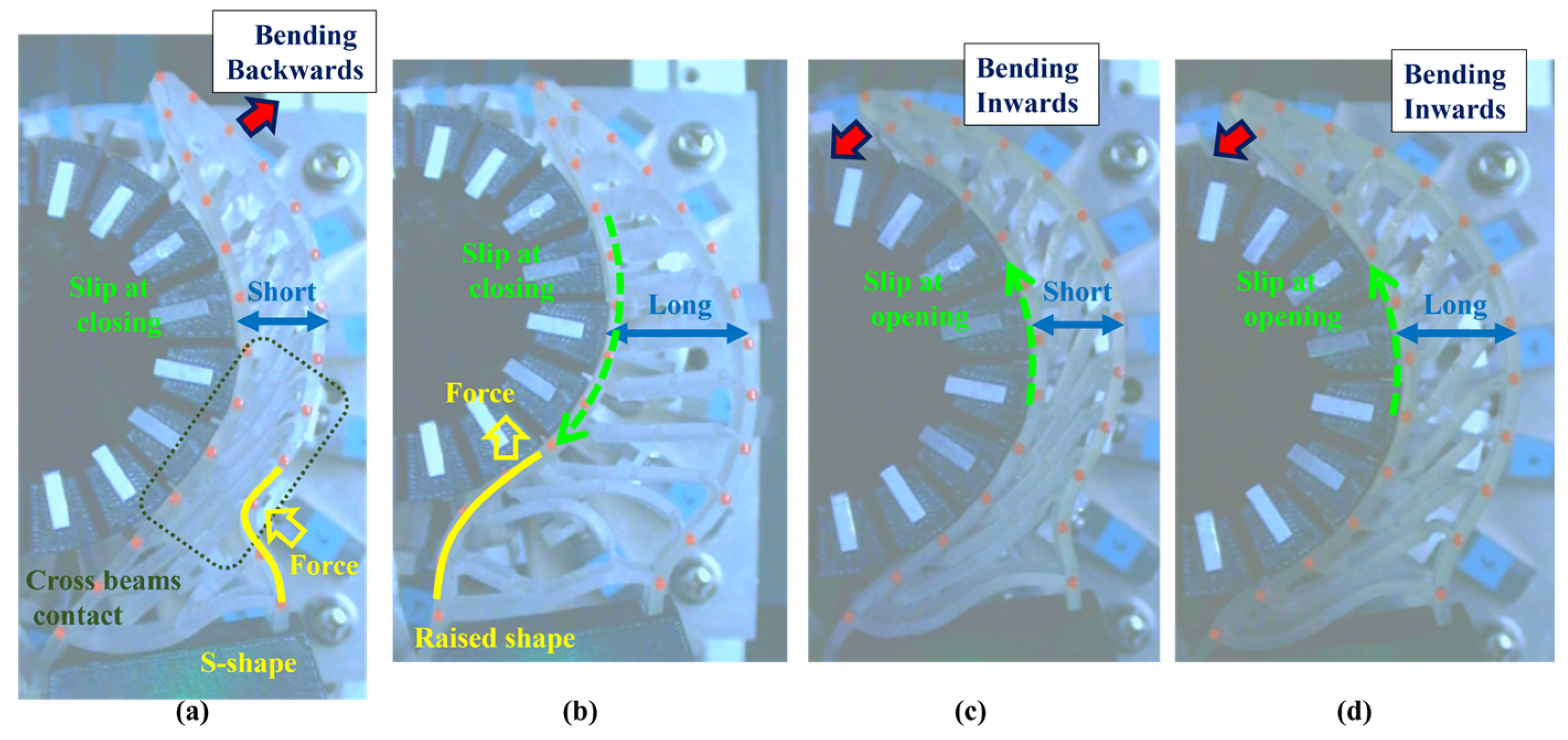
 | Handling Start [mm] | Handling [mm] | Handling End [mm] | |
| −30° | 0 | +9.7 (± 5.1) | +10.8 (±5.3) | |
| −15° | 0 | −9.0 (±0.2) | −5.5 (±1.2) | |
| 0° | 0 | −10.7 (±0.3) | −4.8 (±0.3) | |
| +15° | 0 | −11.5 (±0.2) | −1.7 (±0.5) | |
| +30° | 0 | +10.2 (±1.2) | +13.8 (±0.8) |
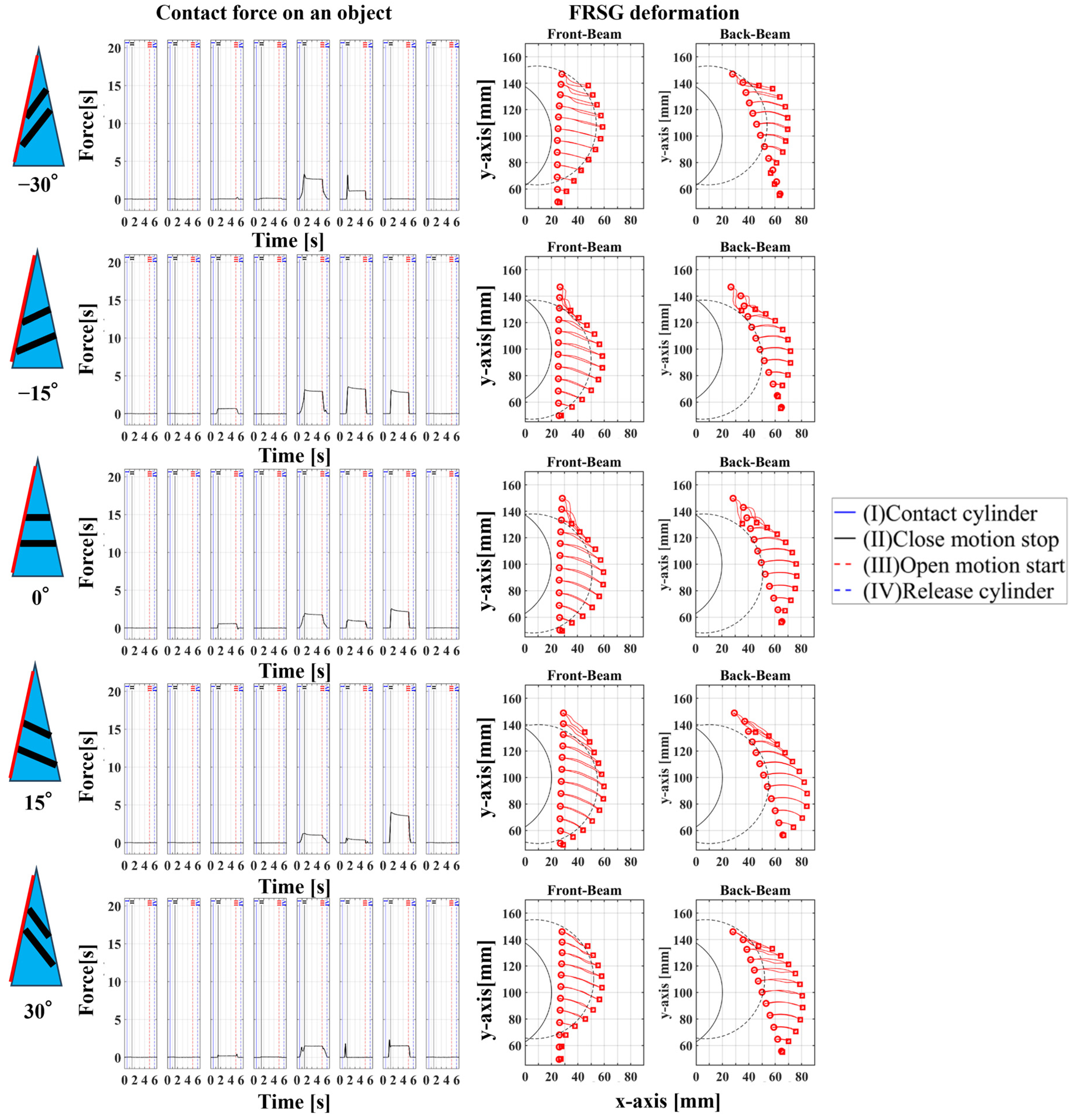
 | Handling Start [mm] | Handling [mm] | Handling End [mm] | |
| −30° | 10 | −2.2 (±0.2) | −0.4 (±0.1) | |
| −15° | 10 | −8.9 (±0.2) | −4.6 (±0.2) | |
| 0° | 10 | −8.1 (±0.1) | −5.2 (±0.3) | |
| +15° | 10 | −9.9 (±0.1) | −4.9 (±0.5) | |
| +30° | 10 | −0.0 (±0.1) | +3.8 (±0.2) |
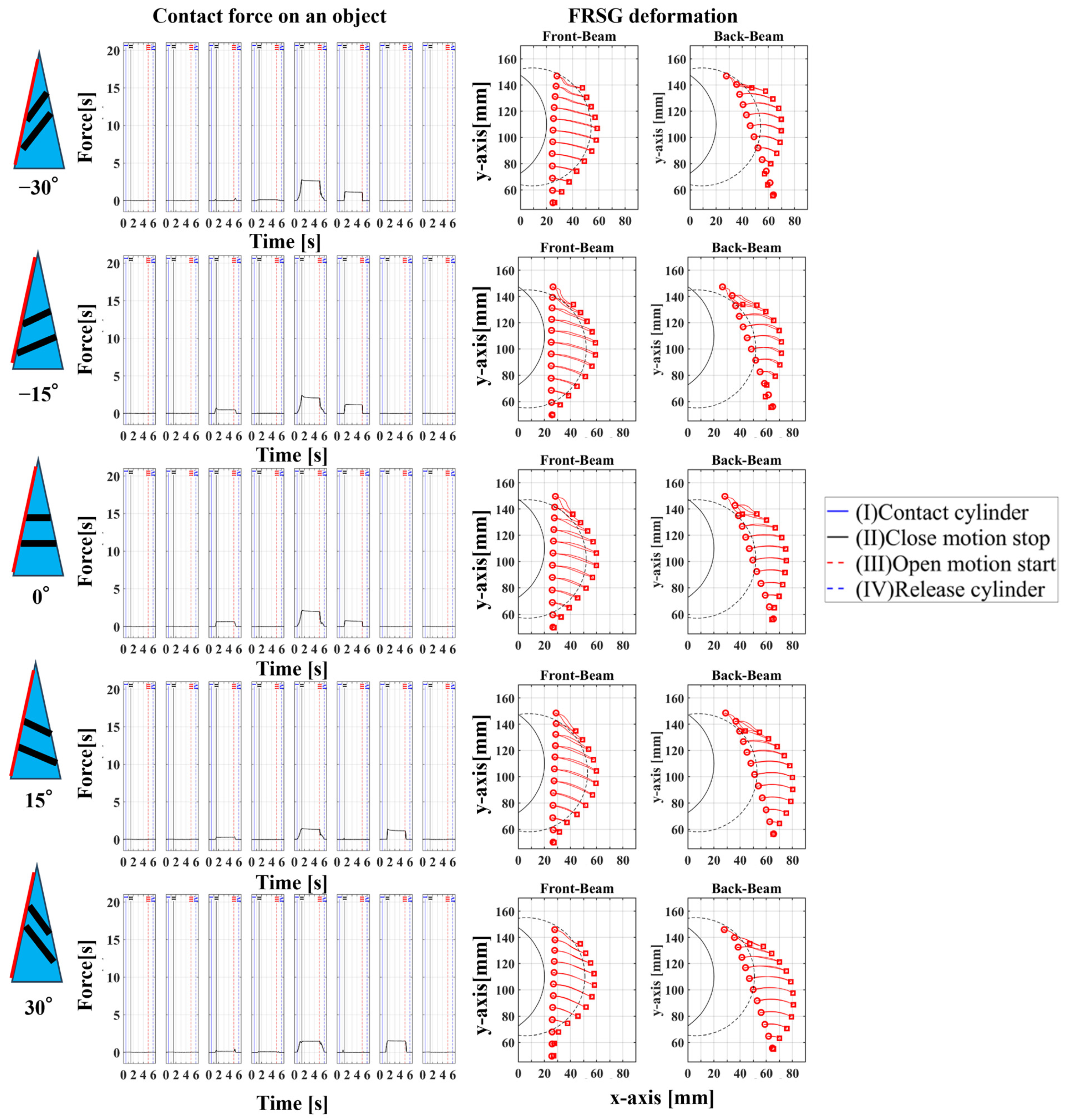
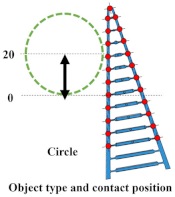 | Handling Start [mm] | Handling [mm] | Handling End [mm] | |
| −30° | 20 | −3.1 (± 0.3) | −3.0 (±0.3) | |
| −15° | 20 | −7.2 (±0.1) | −6.4 (±1.2) | |
| 0° | 20 | −6.1 (±0.1) | −4.9 (±0.2) | |
| +15° | 20 | −7.6 (±0.1) | −7.5 (±0.2) | |
| +30° | 20 | −3.2 (±1.2) | −2.9 (±0.8) |

4. Experiment 2: Analysis of Grasping State When Grasping an Angular Object Shape Like a Square
4.1. Grasping Analysis of Five Types of FRSG for a Square Object (0 Degrees)
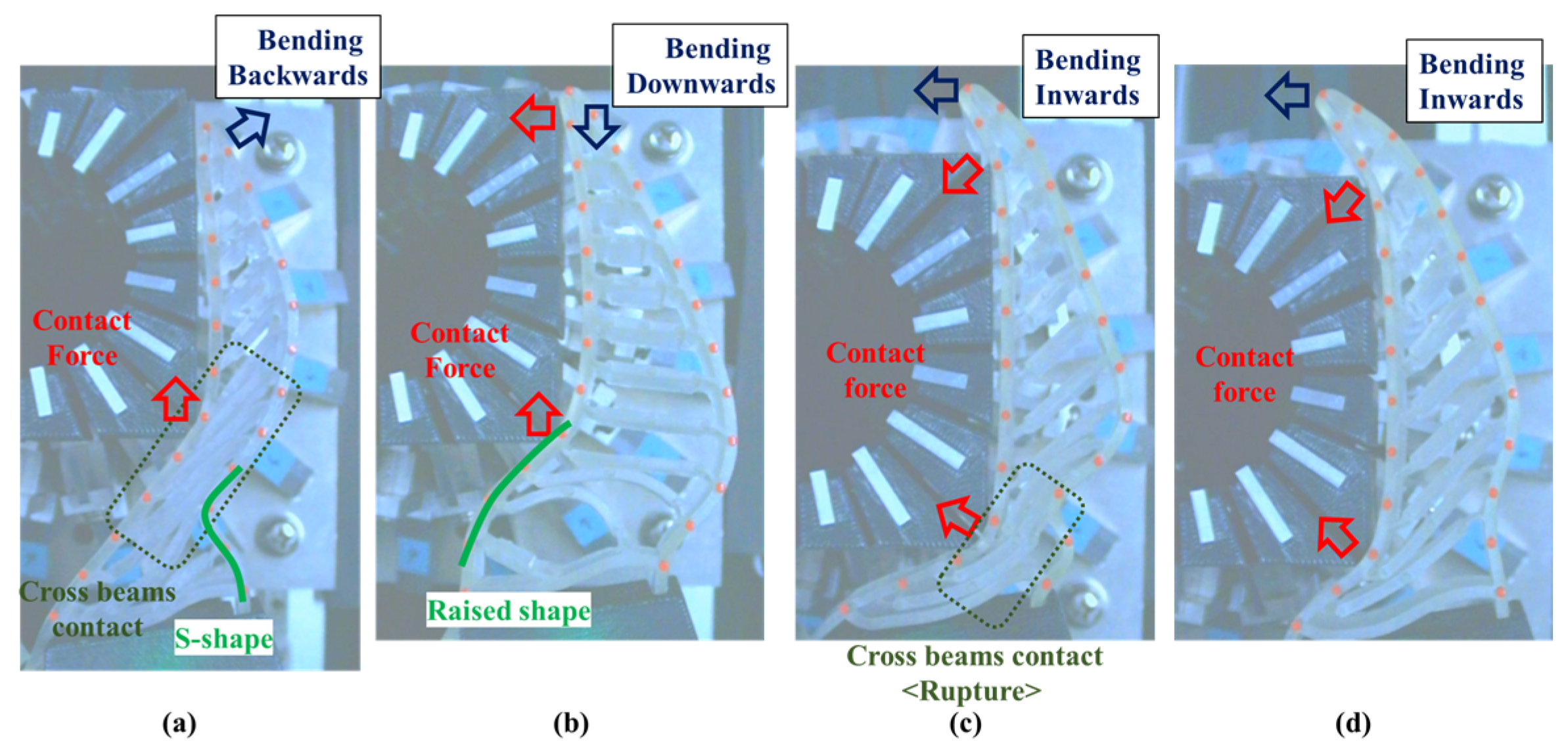
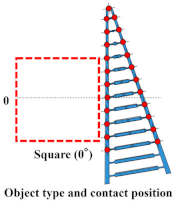 | Handling Start [mm] | Handling [mm] | Handling End [mm] | |
| −30° | 0 | +29.1 (±0.0) | +29.0 (±0.0) | |
| −15° | 0 | −2.1 (±0.7) | −4.0 (±1.0) | |
| 0° | 0 | −1.9 (±0.1) | +7.4 (±2.4) | |
| +15° | 0 | −1.4 (±0.8) | +8.1 (±0.9) | |
| +30° | 0 | +23.1 (±0.6) | +29.1 (±0.0) |

 | Handling Start [mm] | Handling [mm] | Handling End [mm] | |
| −30° | 10 | +19.0 (±0.0) | +19.0 (±0.0) | |
| −15° | 10 | −6.7 (±0.1) | −3.4 (±0.3) | |
| 0° | 10 | −9.9 (±0.1) | −4.7 (±0.8) | |
| +15° | 10 | −10.6 (±2.0) | +1.1 (±2.0) | |
| +30° | 10 | +10.0 (±1.8) | +14.5 (±2.2) |
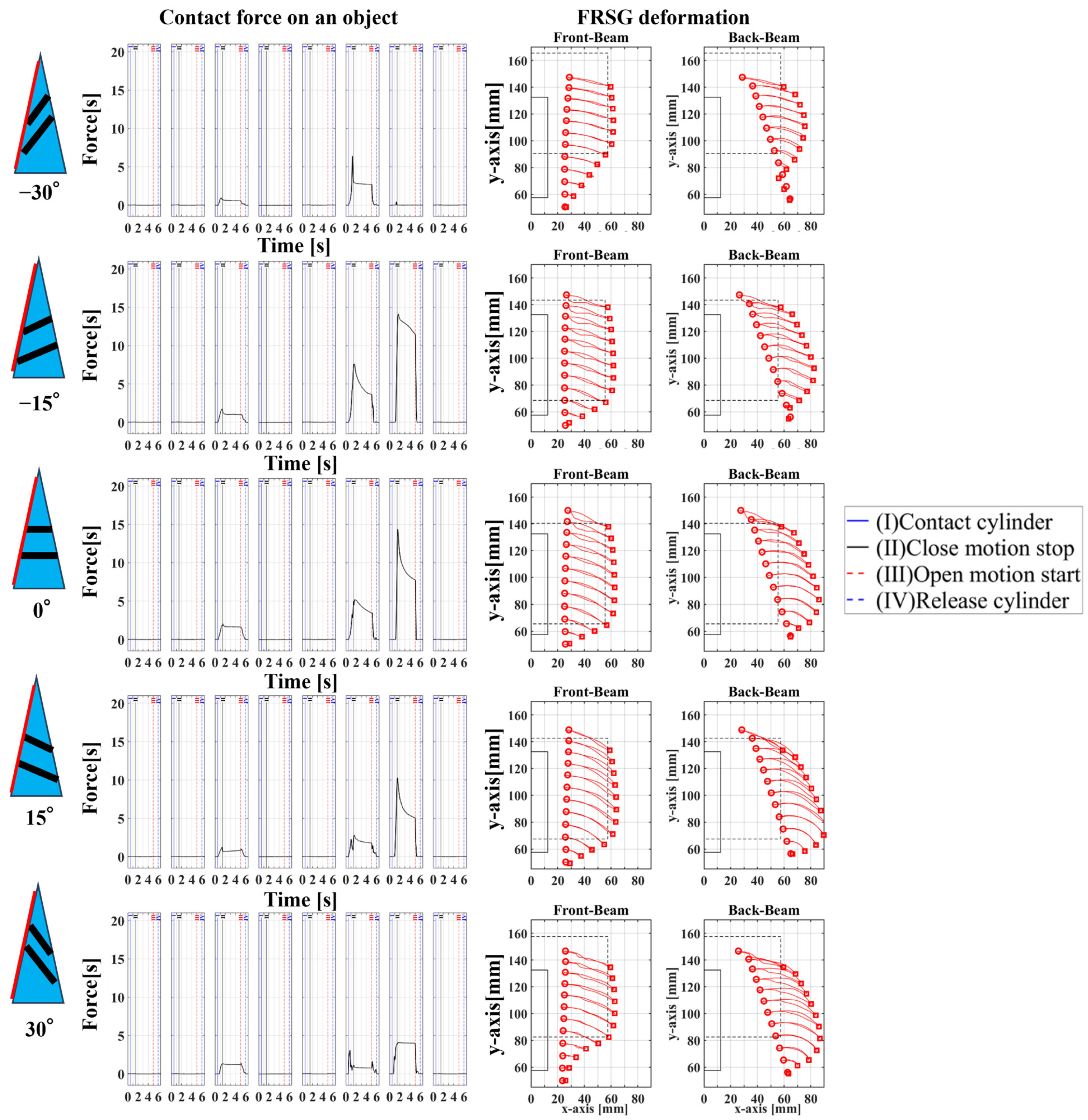
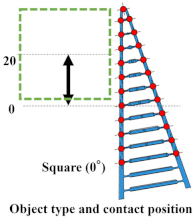 | Handling Start [mm] | Handling [mm] | Handling End [mm] | |
| −30° | 20 | 9.0 (±0.0) | 9.0 (±0.0) | |
| −15° | 20 | −8.9 (±0.4) | −4.0 (±7.0) | |
| 0° | 20 | −12.2 (±0.1) | −7.5 (±0.3) | |
| +15° | 20 | −13.5 (±0.1) | −5.4 (±0.6) | |
| +30° | 20 | +0.6 (±0.4) | +6.5 (±1.4) |

4.2. Grasping Analysis of Five Types of FRSG for a Square Object (45 Degrees)

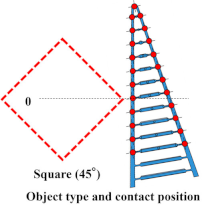 | Handling Start [mm] | Handling [mm] | Handling End [mm] | |
| −30° | 0 | −0.6 (±0.9) | 4.1 (±0.7) | |
| −15° | 0 | −7.1 (±0.1) | −2.8 (±0.2) | |
| 0° | 0 | −8.2 (±0.1) | −4.2 (±0.5) | |
| +15° | 0 | −3.5 (±1.9) | 1.5 (±2.6) | |
| +30° | 0 | +7.5 (±0.5) | +9.1 (±2.4) |

 | Handling Start [mm] | Handling [mm] | Handling End [mm] | |
| −30° | 10 | −3.8 (±0.6) | 4.1 (±0.7) | |
| −15° | 10 | −11.7 (±0.6) | −7.4 (±0.4) | |
| 0° | 10 | −12.7 (±0.5) | −8.5 (±0.7) | |
| +15° | 10 | −12.8 (±0.5) | −5.4 (±0.8) | |
| +30° | 10 | −0.6 (±0.2) | +4.1 (±1.8) |
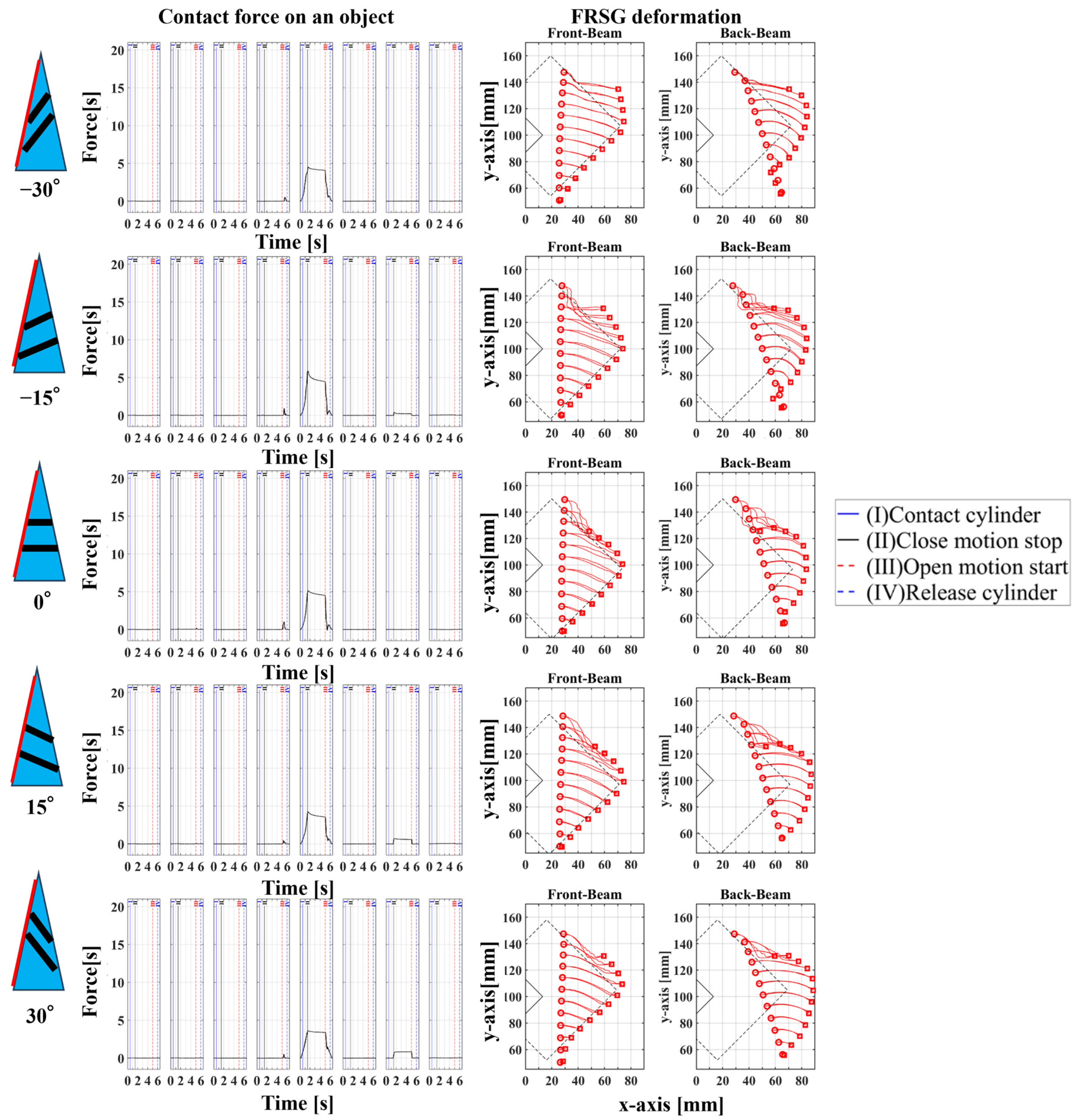
 | Handling Start [mm] | Handling [mm] | Handling End [mm] | |
| −30° | 10 | −3.8 (±0.6) | 4.1 (±0.7) | |
| −15° | 10 | −11.7 (±0.6) | −7.4 (±0.4) | |
| 0° | 10 | −12.7 (±0.5) | −8.5 (±0.7) | |
| +15° | 10 | −12.8 (±0.5) | −5.4 (±0.8) | |
| +30° | 10 | −0.6 (±0.2) | +4.1 (±1.8) |

5. Conclusions
Author Contributions
Funding
Institutional Review Board Statement
Informed Consent Statement
Data Availability Statement
Conflicts of Interest
References
- Hernandez, J.; Sunny, M.S.H.; Sanjuan, J.; Rulik, I.; Zarif, M.I.I.; Ahamed, S.I.; Ahmed, H.U.; Rahman, M.H. Current Designs of Robotic Arm Grippers: A Comprehensive Systematic Review. Robotics 2023, 12, 5. [Google Scholar] [CrossRef]
- Soft Robotics Inc. mGrip. 2018. Available online: https://www.softroboticsinc.com/ (accessed on 28 November 2023).
- Empire Robotics Inc. VERSABALL® Gripper. 2018. Available online: https://www.empirerobotics.com/products/ (accessed on 28 November 2023).
- Dilibal, S.; Sahin, H.; Danquah, J.O.; Emon, O.F.; Choi, J.-W. Additively Manufactured Custom Soft Gripper with Embedded Soft Force Sensors for an Industrial Robot. Int. J. Precis. Eng. Manuf. 2021, 22, 709–718. [Google Scholar] [CrossRef]
- Sun, T.; Chen, Y.; Han, T.; Jiao, C.; Lian, B.; Song, Y. A soft gripper with variable stiffness inspired by pangolin scales, toothed pneumatic actuator, and autonomous controller. Robot. CIM-INT Manuf. 2020, 61, 101848. [Google Scholar] [CrossRef]
- Hao, Y.; Visell, Y. Beyond Soft Hands: Efficient Grasping with Non-Anthropomorphic Soft Grippers. Front. Robot. AI 2021, 8, 632006. [Google Scholar] [CrossRef] [PubMed]
- Pfaff, O.; Simeonov, S.; Cirovic, I.; Stano, P. Application of Finray Effect approach for production process automation. Ann. DAAAM Proc. 2011, 22, 1247–1248. [Google Scholar]
- Festo Gmbh. MultiChoiceGripper. 2014. Available online: https://www.festo.com/net/SupportPortal/Files/333986/Festo_MultiChoiceGripper_en.pdf (accessed on 28 November 2023).
- Festo Gmbh. Adaptive Gripper Fingers DHAS. 2017. Available online: https://www.festo.com/cat/en-gb_gb/data/doc_ENGB/PDF/EN/DHAS_EN.PDF (accessed on 28 November 2023).
- Hemming, J.; Bac, C.W.; van Tuijl, B.A.; Barth, R.; Bontsema, J.; Pekkeriet, E.J.; Van Henten, E. A robot for harvesting sweet pepper in greenhouses. In Proceedings of the International Conference of Agricultural Engineering (Zurich), Zurich, Switzerland, 6–10 July 2014. [Google Scholar] [CrossRef]
- Elgeneidy, K.; Fansa, A.; Hussain, I.; Goher, K. Structural Optimization of Adaptive Soft Fin Ray Fingers with Variable Stiffening Capability. In Proceedings of the 2020 3rd IEEE International Conference on Soft Robotics (RoboSoft), New Haven, CT, USA, 15 May–15 July 2020; pp. 779–784. [Google Scholar] [CrossRef]
- Manoonpong, P.; Rajabi, H.; Larsen, J.C.; Raoufi, S.S.; Asawalertsak, N.; Homchanthanakul, J.; Tramsen, H.T.; Darvizeh, A.; Gorb, S.N. Fin Ray Crossbeam Angles for Efficient Foot Design for Energy-Efficient Robot Locomotion. Adv. Intell. Syst. 2021, 4, 2100133. [Google Scholar] [CrossRef]
- Zhou, H.; Wang, X.; Kang, H.; Chen, C. A Tactile-enabled Grasping Method for Robotic Fruit Harvesting. arXiv 2021, arXiv:2110.09051. [Google Scholar] [CrossRef]
- Zapciu, A.; Constantin, G. Additive manufacturing integration of thermoplastic conductive materials in intelligent robotic end effector systems. Proc. Manuf. Syst. 2016, 11, 201–206. [Google Scholar]
- Hashizume, J.; Huh, T.M.; Suresh, S.A.; Cutkosky, M.R. Capacitive Sensing for a Gripper with Gecko-Inspired Adhesive Film. IEEE Robot. Autom. Lett. 2019, 4, 677–683. [Google Scholar] [CrossRef]
- Liu, S.Q.; Adelson, E.H. GelSight Fin Ray: Incorporating Tactile Sensing into a Soft Compliant Robotic Gripper. In Proceedings of the IEEE 5th International Conference on Soft Robotics (RoboSoft), Edinburgh, UK, 4–8 April 2022; pp. 925–931. [Google Scholar] [CrossRef]
- Liu, S.Q.; Ma, Y.; Adelson, E.H. GelSight Baby Fin Ray: A Compact, Compliant, Flexible Finger with High-Resolution Tactile Sensing. In Proceedings of the 2023 IEEE International Conference on Soft Robotics (RoboSoft), Singapore, 3–7 April 2023; pp. 1–8. [Google Scholar] [CrossRef]
- Liu, S.Q.; Yañez, L.Z.; Adelson, E.H. GelSight EndoFlex: A Soft Endoskeleton Hand with Continuous High-Resolution Tactile Sensing. In Proceedings of the 2023 IEEE International Conference on Soft Robotics (RoboSoft), Singapore, 3–7 April 2023; pp. 1–6. [Google Scholar] [CrossRef]
- Shan, X.; Birglen, L. Modeling and analysis of soft robotic fingers using the fin ray effect. Int. J. Robot. Res. 2020, 39, 1686–1705. [Google Scholar] [CrossRef]
- Suder, J.; Bobovský, Z.; Mlotek, J.; Vocetka, M.; Oščádal, P.; Zeman, Z. Structural Optimization Method of a FinRay Finger for the Best Wrapping of Object. Appl. Sci. 2021, 11, 3858. [Google Scholar] [CrossRef]
- Stuhne, D.; Tabak, J.; Polic, M.; Orsag, M. Design and Prototyping of Soft Finger AI-Enabled Hand (SofIA). In Proceedings of the 2022 IEEE/ASME International Conference on Advanced Intelligent Mechatronics (AIM), Sapporo, Japan, 11–15 July 2022; pp. 1581–1586. [Google Scholar] [CrossRef]
- De Barrie, D.; Pandya, M.; Pandya, H.; Hanheide, M.; Elgeneidy, K. A Deep Learning Method for Vision Based Force Prediction of a Soft Fin Ray Gripper Using Simulation Data. Front. Robot. AI 2021, 8, 631371. [Google Scholar] [CrossRef] [PubMed]
- Deng, Z.; Li, M. Learning Optimal Fin-Ray Finger Design for Soft Grasping. Front. Robot. AI 2021, 7, 590076. [Google Scholar] [CrossRef] [PubMed]
- Kitamura, T.; Matsushita, K. Development and Performance Verification of a 16-directional Distributed Contact Force and Side Structure Deformation Evaluation System for Actual FinRay Type Soft Gripper. Sensors 2023, in press.
- Quteishat, A.; Al-Mofleh, A.; Abuhamdah, A. Tracking Colored Objects Using Kalman Filter. Aust. J. Basic Appl. Sci. 2014, 8, 532–540. [Google Scholar]
- Abdel-Hadi, A. Real-time object tracking using color-based Kalman particle filter. In Proceedings of the 2010 International Conference on Computer Engineering & Systems, Cairo, Egypt, 30 November–2 December 2010; pp. 337–341. [Google Scholar] [CrossRef]
- Kobayashi, A.; Kinugawa, J.; Arai, S.; Kosuge, K. Design and Development of Compactly Folding Parallel Open-Close Gripper with Wide Stroke. In Proceedings of the 2019 IEEE/RSJ International Conference on Intelligent Robots and Systems (IROS), Macau, China, 3–8 November 2019; pp. 2408–2414. [Google Scholar] [CrossRef]
- Courchesne, J.; Cardou, P.; Rachide Onadja, P.A. A compact underactuated gripper with two fingers and a retractable suction cup. Front. Robot. AI 2023, 10, 1066516. [Google Scholar] [CrossRef] [PubMed]
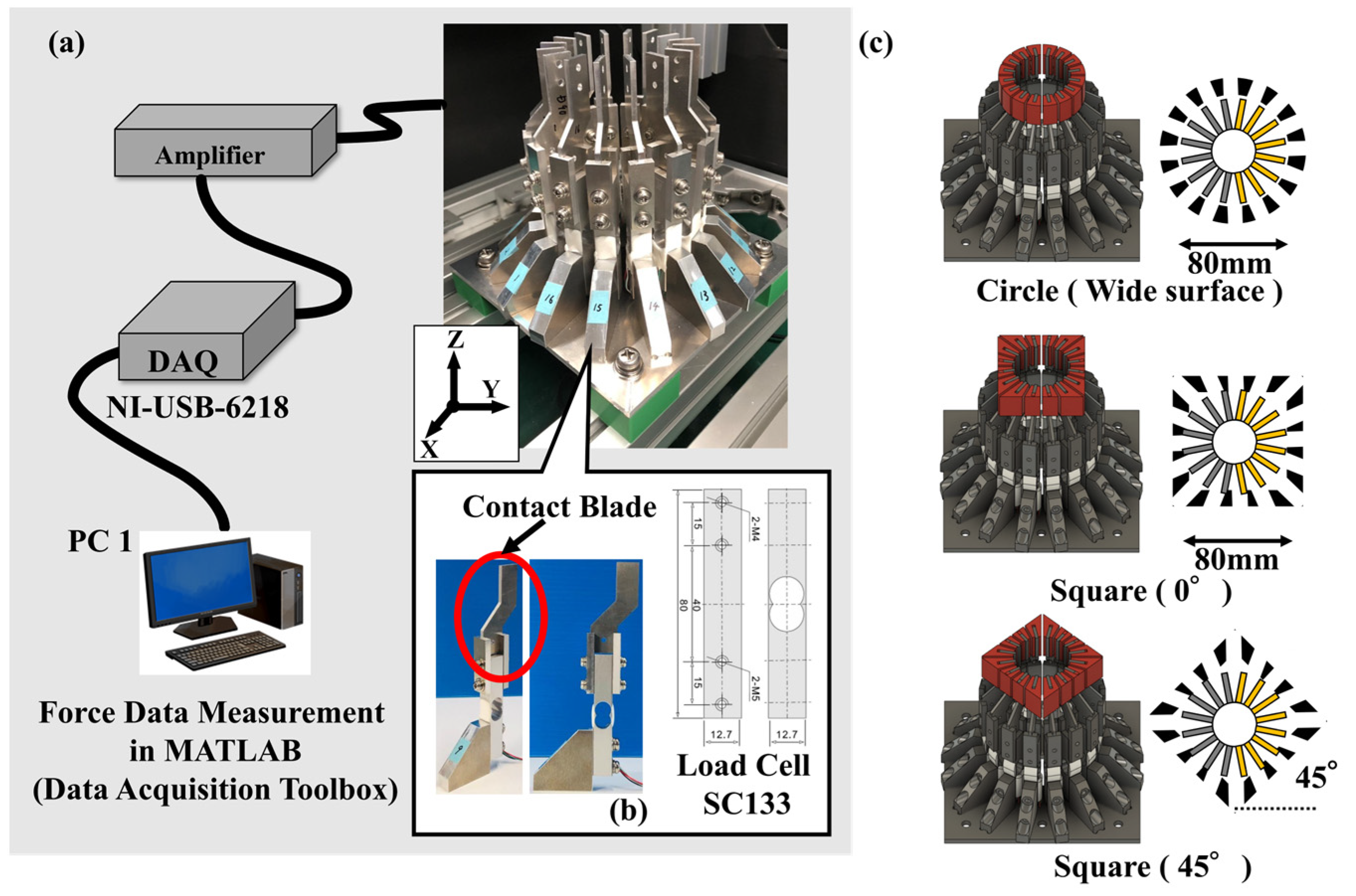
Disclaimer/Publisher’s Note: The statements, opinions and data contained in all publications are solely those of the individual author(s) and contributor(s) and not of MDPI and/or the editor(s). MDPI and/or the editor(s) disclaim responsibility for any injury to people or property resulting from any ideas, methods, instructions or products referred to in the content. |
© 2023 by the authors. Licensee MDPI, Basel, Switzerland. This article is an open access article distributed under the terms and conditions of the Creative Commons Attribution (CC BY) license (https://creativecommons.org/licenses/by/4.0/).
Share and Cite
Kitamura, T.; Matsushita, K.; Nakatani, N. Analysis of Contact Force and Shape Change on Grasping a Square Object Using an Actual Fin Ray Soft Gripper. Sensors 2023, 23, 9827. https://doi.org/10.3390/s23249827
Kitamura T, Matsushita K, Nakatani N. Analysis of Contact Force and Shape Change on Grasping a Square Object Using an Actual Fin Ray Soft Gripper. Sensors. 2023; 23(24):9827. https://doi.org/10.3390/s23249827
Chicago/Turabian StyleKitamura, Takahide, Kojiro Matsushita, and Naoki Nakatani. 2023. "Analysis of Contact Force and Shape Change on Grasping a Square Object Using an Actual Fin Ray Soft Gripper" Sensors 23, no. 24: 9827. https://doi.org/10.3390/s23249827




